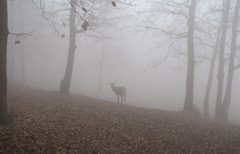The Rupe di Campotrera Oriented Nature Reserve
Both the castle of Rossena and the Tower of Rossenella are included in the Rupe di Campotrera Oriented Nature Reserve, a fascinating and appealing naturalistic area that is easily explored. In these wild surroundings, the presence of man seems particularly far-off, but even in the recent past the area was the subject of intense quarrying. In fact, at the two east-west extremes, the Rupe (Rock) is visibly eaten away by traces of past excavation and former quarry faces which, by slicing through the slopes, have revealed the geological structure of the feature and its different kinds of rock.
The mount is almost entirely formed from very ancient basaltic lava, magma from the Earth’s mantle, which erupted in the Superior Jurassic, 150 million years ago, due to extensive volcanic apparatus on the bed of the Ligurian-Piedmontese ocean. The Campotrera lava, like that of the nearby rocks at Rossenella and Rossena, has a typical “cushion” structure. These basaltic lavas, poor in silica but rich in iron and magnesium minerals with their deep red hue due to the formation of iron oxides, gave rise to the local placenames, Rossena and Rossenella from the Italian word for red, rosso.
Amongst the Rock’s many dark outcrops, just below its summit is a singular much lighter outcrop which can be seen even from a distance: this is a small strip of granite, one of the rarest and most fascinating of the rocks associated with the Apennine ophiolites, which, in this context, almost certainly represents a tiny fragment of continental crust, showing the transition between the rocks of the ancient European and African continents and the Ligurian-Piedmontese ocean floor. Amongst the myriad minerals found, the one that stands out is the rare pink datolite, with stunning crystal formations. The Reserve stretches over 56 hectares and because of its uncommon natural habitats and surprising wealth of biodiversity, has been included on the European Union’s list of “sites of interest”.
Ophiolite rock notably conditions herbaceous vegetation, determining a high concentration of rare species, a real natural botanic garden that warrants maximum care and attention. Here, the heat of the sun, trapped by the rock and then slowly released, has permitted certain vegetal species, which would not normally survive at these latitudes, to acclimatize themselves. The imposing rocky walls scarred by the old quarries, the rocky slopes facing them and the pioneer meadows interspersed with bare rock are the reserve’s most significant features, where the main botanical species are concentrated.
In these harsh, merciless places a set of herbs and dwarf bushes have sprung up through natural selection coping in an exemplary way with the excessive dryness, strong sunlight, paucity of nutritive substances and high concentration of heavy metals, transforming these apparently desert-like places into a striking rock garden with their vivid spring flowers. Amongst the rocks coloured by lichen, and in the shadowy fissures covered in mosses and sprigs of small ferns, are many succulent plants such as Jove’s beard and wall-pepper, with their stalks often reddened by the pigments that these plants produce in the presence of heavy metals in the substrates. As evident as it is unusual is the dwarf prickly pear, opuntia compressa, a spiny cactus originally from North America and imported into Italy long ago.
Over half the protected area is occupied by mixed oak woods alternating with large clearings, to create a sharp micro-climatic contrast with the surrounding open areas, where there is also a notable selection of shrubs including juniper, lantana, broom, hawthorn and butcher’s broom. In the most extreme situations, near the ophiolite grasslands, there are Pyrus Amygdaliformis, a member of the rose family and a species typical of Mediterranean scrubland, as well as Rosa gallica, with its large bright pink flowers. In the glades it is not difficult to stumble upon numerous species of wild orchids. The presence of animals is favoured by the scarcity of pollutants, indeed it is possible to come across many of the animal species that live all over the Middle Apennines. The protected area is also home to a fine variety of birds, including species like the nighthawk, shrike, ortolan bunting and woodlark, which are included amongst the protected species of Europe.
Larger fauna includes the occasional fallow deer and above all roe deer and boar, which easily adapt to the reserve’s environment. The fox is the easiest carnivore to come across even if, as is true for the badger and the marten, its presence is more noticeable due to frequent trails and lairs. The crystal clear waters of some springs are home to such rare fauna as gudgeon and freshwater shrimp.
